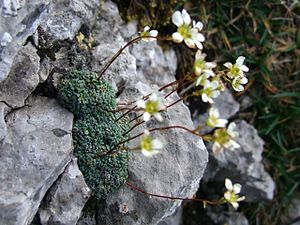Blue-green saxifrage
| Blue-green saxifrage | ||||||||||||
|---|---|---|---|---|---|---|---|---|---|---|---|---|

Blue-green saxifrage ( Saxifraga caesia ) |
||||||||||||
| Systematics | ||||||||||||
|
||||||||||||
| Scientific name | ||||||||||||
| Saxifraga caesia | ||||||||||||
| L. |
The blue-green saxifrage ( Saxifraga caesia ) is a plant of the genus saxifrage ( Saxifraga ) in the family of the Saxifragaceae (Saxifragaceae). It is also known as the pike blue saxifrage . The specific epithet is derived from the Latin caesius for blue-green, blue-gray and refers to the color of the leaves.
description
The blue-green saxifrage grows as a perennial , herbaceous plant and forms loose, flat, not very hard cushions. The foliage leaves standing in basal rosettes are blue-green, between 2 and 5 millimeters long and 0.7 to 1.5 millimeters wide. The spatulate leaves are bent back from the base and strongly bent outwards (downwards). The leaves are thick and blunt at the front. The leaves have five to seven lime- secreting pits and are therefore often covered with a light gray layer of lime.
In the hardly leafed and 2 to 15 centimeter high inflorescences there are usually one to five flowers. The white petals are egg-shaped, five-nerved and 3 to 4 mm long.
The flowering period extends from July to September.
The species has chromosome number 2n = 26
Occurrence
The distribution area includes the Alps , Pyrenees , the Apennines, the Balkans and the Carpathians. The species does not occur outside of Europe.
The limestone plant prefers limestone rocks and rubble, rocky lawns and upholstered sedge lawns at altitudes between 800 and 3,000 meters. In the Allgäu Alps, it rises in the Tyrolean part on the west ridge of the Biberkopf up to 2460 m above sea level. The blue-green saxifrage is a character species of the Caricetum firmae (Association Seslerion albicantis). But it also occurs in societies of the class Asplenietea trichomanis or as a drift in the gravel of mountain rivers.
ecology
The first colonization of the limestone rubble is carried out by this type of plant, which can germinate in fine soil, for example above a high rock. The root formation strengthens the small area and increases the damming effect. The upholstered sedge ( Carex company ) can now settle above the saxifrage, which means that further fine soil is collected and further plants can settle.
literature
- Xaver Finkenzeller: Alpine flowers , ISBN 3-576-11482-3
- Wolfgang Adler, Karl Oswald, Raimund Fischer: Excursion flora of Austria. Ed .: Manfred A. Fischer . Ulmer, Stuttgart / Vienna 1994, ISBN 3-8001-3461-6 .
- Herbert Reisigl, Richard Keller: Alpine plants in the habitat , Stuttgart 1994, ISBN 3-437-20516-1
supporting documents
- ↑ Jaakko Jalas, Juha Suominen, Raino Lampinen, Arto Kurtto: Atlas florae europaeae . Volume 12 (Resedaceae to Platanaceae). Page 146, Helsinki 1999. ISBN 951-9108-12-2
- ↑ Erhard Dörr, Wolfgang Lippert : Flora of the Allgäu and its surroundings. Volume 1, IHW, Eching 2001, ISBN 3-930167-50-6 , p. 658.
- ^ Erich Oberdorfer : Plant-sociological excursion flora for Germany and neighboring areas . 8th edition. Verlag Eugen Ulmer, Stuttgart 2001, ISBN 3-8001-3131-5 . Page 489.
Web links
- Blue-green saxifrage. In: FloraWeb.de.
- Blue-green saxifrage . In: BiolFlor, the database of biological-ecological characteristics of the flora of Germany.
- Profile and distribution map for Bavaria . In: Botanical Information Hub of Bavaria .
- Saxifraga caesia L. In: Info Flora , the national data and information center for Swiss flora . Retrieved November 1, 2015.
- Thomas Meyer: Data sheet with identification key and photos at Flora-de: Flora von Deutschland (old name of the website: Flowers in Swabia )

